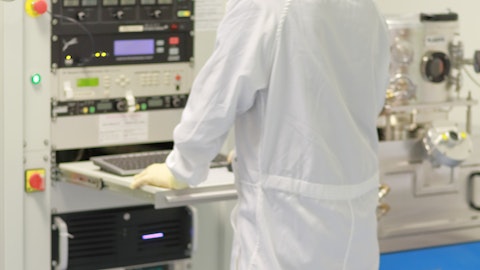It’s been now a couple of years since any of these tools have been upgraded, and that will have to happen. In terms of your comment about offset, I think we’ll — typically, as customers start to turn the tools back on, you’re probably a couple of quarters away from seeing further investments in the technology upgrades. And then I think when you’re really talking about capacity adds, it’s hard to predict what that time frame is because it really depends on many other factors about our customers’ use of long-term demand. So I think the one thing we’re certain is that we’re at very low points now. We would anticipate things like utilization and spares and upgrades to start improving next year. And beyond that, I think we’ll wait until January to give you a better view.
Vivek Arya: All right. And for my follow-up, another China-related question. Part of your second half strength came, I believe, from clarification of some rules. And I was hoping you would quantify how much of that strength you saw in your shipments came from just that clarification? And does that kind of spill over to early 2024. I’m just trying to tease apart how much is sort of sustainable China strength versus how much is potentially from one-off clarification in rules? Or maybe those were not one-off, right? Maybe they’re also sustainable. So just if you could give us some way to guide us to how we should think about China conceptually in your first half of next year.
Doug Bettinger: Yes, Vivek, we’re not going to guide you next year quite yet. But the clarification of the rules we described isn’t changing, right? So we understood one node that a certain customer was doing was okay to ship to. The rules didn’t change. We just had to do a little work to understand that. Collectively, as an industry, that’s not going to go away. Having said that also, what our commentary on the call so far has been, I don’t know if China is up now on our sideways next tier, but it’s not going away. When we talk to our customers in China, they all communicate roadmaps that have multiyear horizons in front of them. Nothing new came from the regulations that you saw yesterday. So I see a level of sustainability in China as we go into next year and frankly, beyond. They have long-term objectives.
Vivek Arya: Okay. Thank you.
Operator: Thank you. And our next question today comes from Stacy Rasgon with Bernstein Research. Please go ahead.
Stacy Rasgon: HI, guys. Thank for taking my question. For my first question, you talked about in your WFE uptick on non-AM markets driving some of that. Am I oversimplifying? Are you just talking about litho or do you have something else in mind when you made that statement?
Doug Bettinger: Stacy, it’s primarily litho. It’s litho and these restricted fabs in China that we didn’t have complete visibility into what they were doing, frankly. It was those two.
Stacy Rasgon: Got it. You have better visibility now?
Doug Bettinger: I think we do. That’s why we updated the number. We never get this exactly right, but we try to tell you what we think of it now.
Tim Archer: Stacy, some of our visibility comes from the fact that our peer companies are reporting on the business and it’s really their markets. So as the year goes on, we try to give you a view of the whole market, but obviously, we’re most accurate on the Lam business.
Stacy Rasgon: Got it. Got it. But to be clear, I think you said there’s no change to your forecast for the Lam business for the year, whatever that forecast is.
Tim Archer: That’s right. Because we understand that WFE quite well.
Stacy Rasgon: Got it. Got it. And so for my follow-up, I want to go back to the leverage question for next year. So I understand you’re talking about like leverage, like maybe flattening out. Was that just a statement you just think OpEx, I mean, just to put on table OpEx growing with revenue, whatever revenue is? Or given the gross margin compression that we’ll probably see at least from the current level, like do you think operating margins year-over-year could actually go — could decline next calendar year? Or like just how do we think about those different pieces?
Doug Bettinger: Stacy, if you look at what Lam has done over the last, I don’t know, a decade, frankly. We’ve expanded margin as revenue has grown. At this point, I’m not sure what revenue is going to be next year, but I know we’re going to invest more in R&D. That’s what I’m trying to describe because we see all of these opportunities. And yes, I referred to the fact that we’ve got pretty favorable customer mix that likely mitigates somewhat next year. And so when you think about those two things, it’s possible to think about kind of margin flattening off for a period of time. Our long-term profit objectives are unchanged. So I do want to reiterate that point as well.
Stacy Rasgon: Got it. That’s helpful. Thank you guys.
Tim Archer: Thanks, Stacy.
Operator: Thank you. And our next question comes from Srini Pajjuri with Raymond James. Please go ahead.
Srinivas Pajjuri: Thank you. I have a couple of longer-term questions, Tim. I guess if I look at the last five years, your logic and foundry business has been growing almost at a 30% rate. And historically, your memory was close to 60%. And now I think we’re at the bottom kind of moving from 27% to 38% or so this quarter. I’m just curious, how do you think about the mix longer term, I guess, when things normalize for you? And what is, I think, in your view, what do you think is the ideal mix for you? And what implications, if any, that might have on your top line growth going forward?
Tim Archer: Yes. It’s a good question. It’s a hard question to answer because the actual. Our view is we want more of everything. So we’re not looking to reduce our position in memory just to make the mix look better. So we try hard every day. We have a fantastic position in memory, and we think there’s still more to come there as over the next decade, I mean, NAND is going to scale customers saying to 1,000 layers, and that’s a tremendous opportunity for Lam. DRAM going to 3D around the end of the decade, tremendous opportunity for Lam. So I’m afraid the memory side will keep growing simply because it’s so well suited to our strengths. But you have heard us talk a lot about the fact that we see huge opportunity in the foundry logic side as well.



